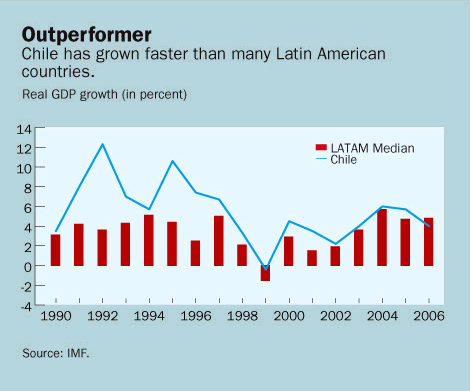Annual Economic Health Check

Typical street scene in Santa Ana, El Salvador. (Photo: iStock)
IMF Survey: Scope to Address Chile's Social Goals
December 20, 2007
- Chile has enjoyed two decades of stability and rising living standards
- Steady and strong growth have helped cut poverty by two thirds
- Income inequality remains high but social policies are being strengthened
Over the past 15 years, Chile's economic reforms and prudent macroeconomic policies have delivered strong growth and low inflation.

Copper foundry at Calama, Chile, where fiscal revenues continue to benefit from strong copper prices (photo: Martin Bernetti/AFP)
Per capita income has tripled in U.S. dollar terms and poverty has been cut by two thirds to 13 percent. Growth has slowed in recent years from its breakneck pace in the mid-1990s but continues on a 5 percent trend.
In the staff report discussed by the IMF's Executive Board in July, the economy was expected to grow by almost 6 percent in 2007 (see chart), following a broad-based upswing in the first half of the year. Since then, the outlook has weakened as global food and energy price shocks have pushed inflation above 6 percent, eroding real incomes.
However, the medium-term inflation outlook remains anchored around the central bank's 3-percent target and, as in many other emerging markets, risk premia in the interbank market and sovereign spreads have risen only moderately in recent months.

With its open economy and liberal trade regime, Chile's macroeconomic policy framework—a floating exchange rate, inflation targeting, and a commitment to running a fiscal surplus—is aimed at mitigating volatility from economic shocks. It has also helped maintain the economy's competitiveness despite the high price volatility of copper, Chile's main export product, and has provided added scope to address social priorities.
Surplus rule anchors fiscal policy
Fiscal revenues have continued to benefit from strong copper prices but susceptibility to commodity price fluctuations remains a concern (Chile accounts for a third of global copper output). Public spending increases are in line with revenues under the country's "fiscal surplus rule," which targets the structural surplus (that is, the fiscal surplus adjusted for deviations of output and copper prices from their long-term equilibria).
Chile adopted the surplus rule in 2000 with the objective to insulate the economy from the effects of volatility in the price of copper. This has helped the country's floating exchange rate to remain both stable and broadly in line with fundamentals.
Chile's nominal fiscal surplus is expected to be well above 7 percent of GDP in 2007, thanks to strong corporate tax receipts and a rebound in value-added tax revenue. Invested government financial assets now exceed 10 percent of GDP and the central government has become a net creditor. Reflecting its stronger financial position, Chile has reduced its fiscal surplus target to ½ percent of GDP from 1 percent beginning in 2008.
The key fiscal challenge, according to the IMF assessment, is for Chile to ensure high-quality public spending. This means carefully weighing the costs and benefits of new projects and improving both the efficiency and transparency of government spending.
Resilient financial markets
Chile's financial markets have been resilient in the face of global financial turbulence, owing to the country's healthy banking system and strong corporate balance sheets. The financial strength reflects major improvements in banking regulation and supervision after a financial crisis in the 1980s.
Capital market reforms in recent years have also helped to raise domestic saving, improve market liquidity and depth, promote access to capital markets for emerging companies, and stimulate competition in the local market. More recently, one focus has been on integrating the financial sector more closely into global capital markets, including in a package of measures passed into law in May 2007.
Structural reforms are broad based
The authorities have a broad structural reform agenda. In addition to capital market reforms, they have proposed a major pension reform to raise benefits, widen coverage, increase returns to saving, and encourage participation in the formal labor market. The proposed reform includes a universal public pension pillar and aims to boost participation by low-income groups and the self-employed.
To address social concerns, a key priority is to improve education and build job-specific human capital. The IMF sees these efforts as "key to raising long-term growth prospects."
At a September 26 press conference, two senior IMF officials did not see the recent changes in global economic conditions greatly affecting Chile's strong economic position. "The risks to the outlook, " they said, however, "are now more on the downside, given uncertainties about the global financial system, the U.S. outlook, and investors' risk appetite, including for emerging markets."
Even so, these officials noted that the impact of recent global financial turbulence had been relatively mild. This was "a strong testimony to [Chile's] very robust macroeconomic framework..., with strong cushions against adverse shocks—a sound fiscal position, low public debt an independent central bank, high international reserves, and a flexible exchange rate."
Assuming no further major shocks or a global downturn, the IMF officials concluded that "growth and employment in Chile will remain relatively strong, benefiting also from Chile's diversified export structure and continued brisk commodity demand."







